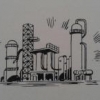Dear Experts,
I'm trying to look for specific design/field experiences relevant to Vapour Recovery Units (VRU) connected to loading of Gasolines.
The selected technology includes Adsorption coupled to Absorption.
The suggested washing liquid is Heavy Gasoline (eg Reformate, Heavy Cracked Naphtha) but, on the base of experience in similar plants in other Refineries, someone would like to investigate if Kerosene or Gasoil could have better (i.e. more economic) performances.
Without any specific experience, I've tried to simulate the washing column in the various cases. The main results of this preliminary investigation are as follows:
- Reformate appears to be too light: the column works as a Stripper, the opposite of an Absorber.
- At equal volumetric flowrates, Kerosene seems to be better than Gasoil (i.e. Kero absorbs more vapours than Gasoil).
Since there are thousand of installations of this kind in the world....
Before going ahead with the analysis I'd like to compare these results with real experiences.
Also references to specific papers, articles, books are welcome.
Thank you in advance,
gegio

 FB
FB











